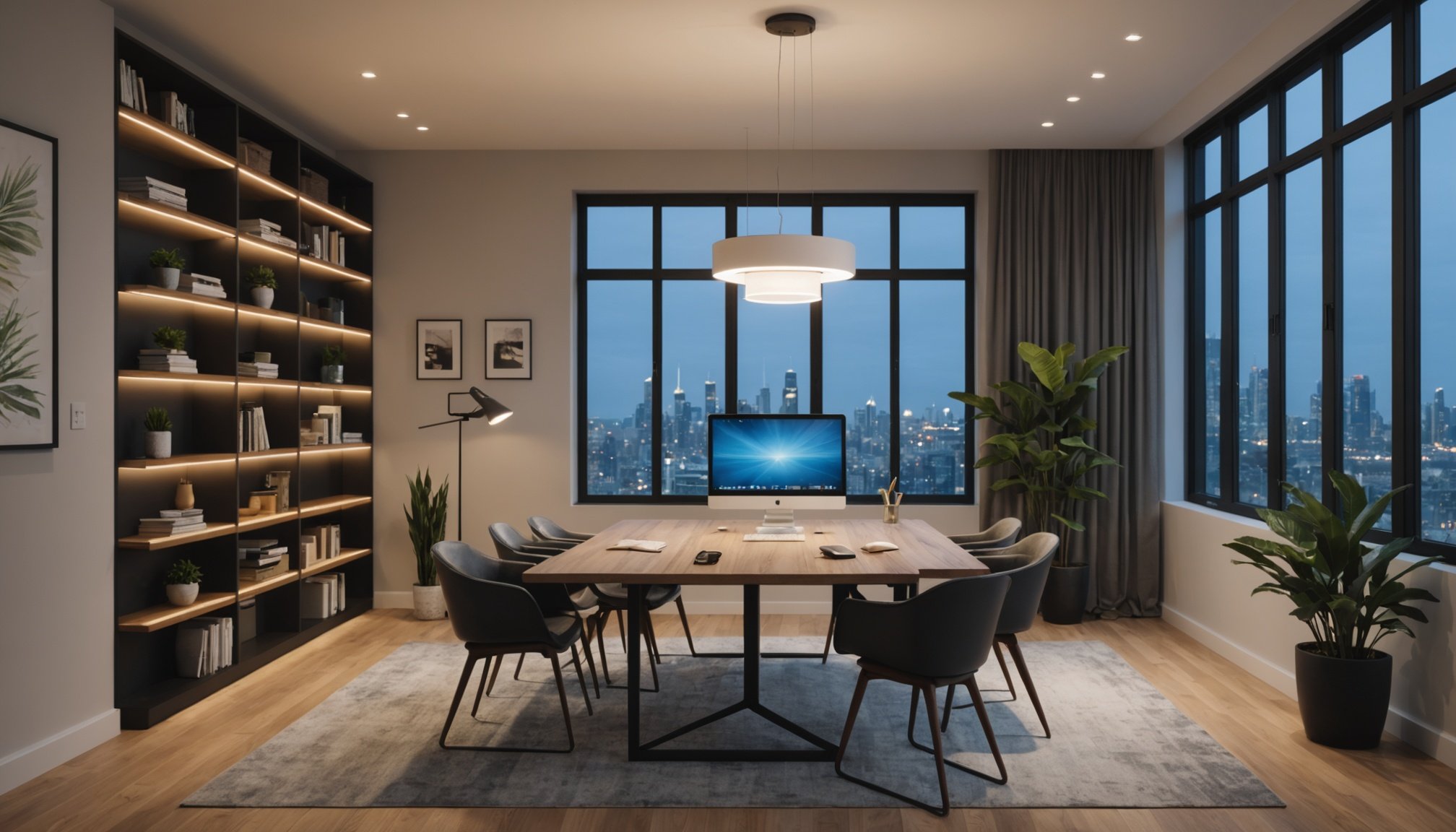Overview of Smart Lighting Technology
Smart lighting harnesses advanced technology to provide seamless automation within homes and businesses. At its core, a smart lighting system consists of interconnected components such as LED bulbs, sensors, and smart controls. These elements work in unison to enhance energy efficiency and offer users greater control over their environments.
Integration with home automation platforms is a key feature of smart lighting. Through this integration, users can program lights to turn on or off at specific times, adjust brightness based on natural light, or even change color to suit their mood or activity. Such flexibility is achieved through applications on smartphones or voice-activated assistants.
Also to see : Transforming Property Investment: The Revolutionary Effect of AI-Powered Analytical Tools
One of the most compelling benefits of smart lighting is its contribution to energy efficiency. Traditional lighting systems often operate at full power regardless of need, whereas smart lighting solutions can adapt to both occupancy and ambient lighting. This means significant reductions in energy consumption, often translating to lower utility bills and reduced carbon footprints.
Smart lighting not only enhances automation, but is a stepping stone towards a more sustainable lifestyle. Through intelligent design and innovative technology, smart lighting continues to evolve, offering a glimpse into the future of efficient energy use.
In the same genre : Transforming User Engagement: How Capacitive Touchscreens Enhance Experience in Consumer Electronics
The Psychological Impact of Lighting on Mood
Lighting plays a significant role in mood enhancement, directly influencing emotional well-being. Research has firmly established that different lighting tones and intensities can evoke various emotions. For instance, warm lighting typically promotes relaxation, while cooler tones are known to enhance alertness. Smart lighting systems, with their versatility, allow users to adjust these parameters according to their needs, effectively modulating their emotional state.
Numerous studies highlight the psychological benefits of lighting. For example, individuals exposed to well-designed lighting report improved mood and decreased feelings of depression. These findings underscore the importance of incorporating smart lighting systems in domestic spaces, where creating a harmonious ambiance might contribute to mental well-being.
Smart lighting offers users the capability to tailor their environments for optimal emotional impact. Surveys indicate that users who frequently alter their lighting settings report higher levels of satisfaction. The adaptability of these systems ensures that users can maintain a suitable atmosphere for relaxation, concentration, or social gatherings.
Mood enhancement through smart lighting is not just limited to residential settings. In workplaces, schools, and hospitals, appropriate lighting can encourage positive emotions and improve overall well-being. Thus, the psychological impact of lighting extends beyond mere utility, becoming a valuable tool for enhancing quality of life.
Smart Lighting and Productivity Enhancement
Productivity in work environments links closely to lighting quality, impacting efficiency and mood. Studies reveal that optimal light conditions significantly improve focus and task performance. Specifically, bright, white lights enhance alertness, while natural light sources boost morale. Smart lighting systems provide adaptability, allowing adjustments suitable for various tasks.
Employers leveraging smart lighting design workplaces that maximise productivity. Workplaces equipped with these systems can easily shift lighting to align with employees’ needs. For instance, in settings demanding high concentration, light intensity can be increased, reducing fatigue and increasing output. Conversely, softer lighting supports collaborative tasks and creativity.
Firms successfully implementing smart lighting document increased productivity and employee satisfaction. Tech companies, for example, frequently report enhancements in focus and creativity. By tailoring light conditions to suit various activities, businesses promote a positive work environment conducive to higher productivity.
Best practices for configuring smart lighting include:
- Ensuring light sources reduce glare
- Using daylight sensors for natural light balance
- Customising settings for individual or team tasks
- Regularly reviewing light conditions to meet evolving productivity goals
By adopting these practices, organisations can fully harness the benefits of smart lighting, supporting both employee well-being and business outcomes.
Practical Applications of Smart Lighting
Smart lighting extends far beyond mere illumination, offering versatile applications for various settings, each with unique user scenarios.
Residential Use Cases
Within the home, smart lighting systems allow homeowners to create customized ambiance. Whether adjusting lights to energize mornings or dimming them for a relaxed evening, users have full control. Smart lighting’s integration with home automation systems facilitates a seamless living experience. For instance, setting schedules for lights to gradually brighten in the morning mirrors natural sunrise, providing a gentle wake-up and promoting a consistent circadian rhythm. Additionally, motion sensors can dim or turn off lights when rooms are unoccupied, enhancing energy efficiency.
Commercial Use Cases
In commercial environments, smart lighting enhances both aesthetic and functional aspects. Retail spaces utilize smart lighting to highlight products, while offices adopt it to support productivity through adaptable light conditions. Businesses benefit from reduced energy costs due to automated adjustments based on both occupancy and time of day.
Educational Settings
Schools and learning institutions find smart lighting particularly impactful for educational settings. Smart lighting aids in maintaining focus and alertness among students, matching lighting tones and intensities with different classroom activities. This technology contributes to a conducive learning environment by aligning light conditions with pedagogical needs, ultimately improving student engagement and performance.
Product Recommendations and Comparisons
When evaluating smart lighting products, several factors such as ease of use, integration capabilities, and energy efficiency are paramount. Smart lighting options are abundant, with products like Phillips Hue, LIFX, and Wyze offering varied features to cater to distinct preferences.
Phillips Hue is renowned for its broad colour spectrum and robust home automation integration. It offers both white and coloured bulbs, compatible with voice assistants such as Alexa and Google Assistant. Users laud its seamless adjustability and reliability in syncing with other smart home devices.
LIFX distinguishes itself with intense brightness and colour vibrancy. It does not require a hub, simplifying setup procedures, and is lauded for creative lighting effects. Despite its higher price point, consumer reviews highlight its superior illumination and responsiveness to user commands.
Wyze provides an affordable entry into smart lighting ecosystems. Though it offers fewer features, its combination of basic automation functions at a lower cost makes it appealing for budget-conscious users.
Consumer testimonials frequently note satisfaction with the personalisation and energy efficiency these products bring. The adaptability of smart lighting not only optimises user experience but also advances sustainability by reducing electricity consumption.
Actionable Insights and Tips for Implementation
Smart lighting systems offer remarkable opportunities for homeowners and businesses aiming to modernise their environments. To maximise benefits, consider these vital implementation tips. Start with a step-by-step guide to choosing products: evaluate brands offering the specific smart features you desire, like voice control or color-changing options.
Before purchasing, assess your environmental requirements. Do you need adaptive lighting in living areas or focused light in workspaces? Once selected, prepare for installation: follow manufacturer guidelines closely and ensure compatibility with existing home automation systems.
When setting up, pay attention to user experience. Customise settings that align with daily routines, like scheduling lights to mimic natural sunrise in bedrooms or using motion detectors in high-traffic areas to conserve energy.
Tips for maximising benefits include routine assessments of light settings and being mindful of common pitfalls. Avoid over-complicating automation sequences, which can overwhelm users rather than simplify daily life.
Lastly, engage with user reviews to gather insights on product performance and customer satisfaction, ensuring a well-informed decision-making process. Proper integration of smart lighting enhances lifestyles, promoting energy efficiency and comfort.


